| |
Tales of Touring Turkey by Fred Moore:
© 2009 by Author
Today we’re traveling to ‘our’ Ottoman House in Goreme; you’ve may have been with us on this trip before, but there’s new road to be driven. The newest portion of the autobahn from Pozanti almost to Nigde has recently opened and we’re going to travel it. We leave Adana at 8:00 am and in no time reach Pozanti in the beautiful Taurus Mountains. We’ve had far more rain this winter than usual and the landscape is awash in multiple patterns of green; from fields stretched out from the roadway to tree-covered mountains, all around us blanketed in dazzling white snow.
Once in Pozanti we pay our toll (as usual) and make a ten-minute rest stop. Back on the road now, we follow the signs to the ramp directing us to the new highway. Where we usually follow the road west of the river we now cross over and head north on the east side of the river. The new road is taking much business from the old truck stops north of the village and when completely finished I believe it will take far more. Pozanti will become just another exit on the road, no longer a stop off as it is now. Continuing on the new highway, we find we’re high above our old rest stop and it appears abandoned. Progress takes a toll once more--sad how that has to happen.
We notice the old highway is still in use and certainly it will remain so for those villages along that route; unfortunately though, the lion’s share of traffic unless specifically going to the villages along the old road, will now take this new modern highway. Only minutes north now we enter our first tunnel. Visualize this; we’re on a modern six-lane expressway cut through the Taurus Mountains. The rugged landscape is sheer cliffs and jagged rock left by millenniums of upheaval and erosion of the earth’s mantle.
As I traverse this first tunnel, I’m struck by the sheer magnitude of work that has gone into my surroundings. The engineering necessary to cut a six-lane highway through a solid rock mountain awes my meager imagination. I’m fully cognizant of the fact this is no longer done with hand-tools but it’s still truly magnificent to experience the reality of it. One tunnel after another (eight in all) consume our drive north and I wonder just where I will be deposited; I have an idea and can’t wait to see the actual destination.
Each tunnel offers its own character; one offers a slight curve while the next is straight and one offers more tunnel than the next. I believe the longest was over 800 meters while the shortest we could see fully through it. Almost without exception, each entry and exist was over a viaduct (some sixteen of them). The vistas offered beyond each tunnel exit defy description using mere words; suffice it to say this virgin landscape blanketed by a concrete corridor carpet is breathtaking!
Our travel time through this part of Turkey has been cut well in half and I’m not sure whether it’s due to this magnificent highway or the majestic landscape it cuts through. Both have certainly contributed because we’ve marveled at each individual panorama spread before us as we exited one tunnel and entered the next. We’ve come out now on the old road between Nigde and Ulukisla; not where I thought we might but fairly close. I actually anticipated coming out closer to Nigde; I believe one day we will indeed come out there as a more modern highway is being built in that direction.
We continue northeast past Nigde and turn north toward Nevsehir; the distant mountains are blanketed in haze so we can see very little of their snow-covered vistas. Immediately after we turn, we cross the worst railroad tracks in country! I thought we might see them smoothed before we left Turkey but it doesn’t appear we will. This is without too much exaggeration the most boring part of the drive to our destination; after we make the slight grade climb the road flattens and the landscape broadens on both sides of the highway. We drive for kilometers without seeing much of anything.
The next village is Gulcok and it’s usually where we stop for the traffic light and then move on. This is one of those communities you simply dash through without taking any notice at all unless you get stopped by the light. At this intersection one can turn west for Guzelyurt and Ihlara Valley. Today, we notice as we drive through, there’s a very large outdoor market taking place. It reminds me that every village has a weekly market like this; vendors descend upon a village with all matter of products. This like many others is produce, dry goods, clothing, fabric, shoes and a multitude of other commodities. Carol wants to stop but I simply drive on. There just isn’t a good reason to stop; I mean, if you’ve walked through one of these you’ve walked through them all! (Carol’s note: spoken like a man, of course! There is always something to see and maybe to buy—but just the ‘seeing’ is fun!)
Once more the drive becomes mundane as we travel on toward Derinkuyu. The road ahead is flat, straight and scenic-less (that’s not a word but fits the picture I’m trying to draw). As I approach Derinkuyu the road splits and I take the by-pass. If you’re planning a visit to, or you’ve never been to this village, be sure to drive through it. There’s a major underground city here worth a visit. Just past the village now the road dips and curves, the scenery takes a bit better view and before you know it you’re in Kaymakli another village with an underground city. This village you must drive through, there’s no bypass; slow down and look at the houses. There are several homes along the main street as you leave the village that are magnificent; we would love to walk through a couple of them. Notice the stone work that make these homes, it’s vastly more elegant than homes you’ve already passed getting this far are very typical of the stone used for building in the Cappadocia region.
It’s only a few more kilometers now and we take another by-pass. This one isn’t truly a by-pass, we simply turn right and drive through Cardak which allows us to cut ten or twenty minutes from our drive. By making this short-cut, we don’t have to drive through Nevsehir. We avoid all the lights and traffic in the ‘big’ city, HaHaHa. This shortcut takes us to Uchisar over the hills; it also passes the local prison compound and a local kolej (a college prep school). There are some very lovely views on this short stretch of road as well.
We drive into Uchisar and then turn left in the village center to go to Goreme. Once out of Uchisar we turn right on the main road and descend the hill toward the tourist shops and curve off toward Goreme. It’s only a few minutes to Goreme on this winding, rolling two-lane asphalt from Uchisar. We pull into the parking spaces at the Ottoman House and before we can get out of the car the guys from inside are waiting for us on the steps. Inside they ask us to relax and have a cup of tea. Ali Bey runs up the stairs to check the room to ensure all is in order before we go up. We’re told our usual suite is not available because they’re having some problems with heat in that corner of the building. Ali returns and simultaneously our tea arrives; we sit with our tea and talk to Ali about the business and tourist season. When we have relaxed for half an hour and talked about our winter in Adana, Ali takes us with our bags to the suite on the third floor at the back of the hotel behind the dining room.
This is a very lovely suite as well but with no balcony; no matter, it has heat and in April in this little village heat is good. The morning is quite chilly and this morning there was a frost. We put away our things and hang our clothes; we decide to walk down to our favorite little kabob café for lunch. We opt for sweaters and breathe deeply as we start down the street; the air here is clean and cool. We step into Cappadocia Kebab and order two chicken doner sandwiches/wraps. Don’t pass up this little place if you want a fast, inexpensive and tasty meal! We’ve been eating here for six years.
After lunch we cross the street and drop down behind the bus stations to visit with our friend Zafer, owner of Moulin Rouge; Carol wants a few things and I need a new hat. We sit and have a glass of tea and talk about our trip and where we plan to visit this time. Zafer tells us business is good and he’s looking forward to the coming season again when the tourists begin to flock to Goreme. He tells us a few have already come though the time is early and the weather is cold.
Carol browses the shop for over an hour; there are three massive rooms of Turkish and Afghan products of every description. I find my hat in minutes and return to sit outside on the patio/porch. Don’t miss this shop on your visit to Goreme; tell Zafer, “Fred & Carol told us to stop by,” he’s a great guy and his English is better than mine! We thank Zafer for the tea, time and conversation; we must get on to see other friends. The weather is wonderful and we take full advantage of it as we stroll the streets saying hello to friends and strangers alike. The pace of life here is slow and everyone we encounter is willing to share some time and conversation. Coming to Goreme is like visiting family; the folks are warm and always friendly.
We stop in to see Ruth and Faruk at Tribal Collections (a very lovely carpet shop), always a real treat. They’re just getting up from lunch with friends and they invite us in for refreshments; at the same time they offer us lunch but we tell them, we’ve already had ours. They acknowledge our choice for lunch and confirm what we know: Cappadocia Kebab is a great lunch stop. We meet a young couple who have bought a home in Goreme; they’ve stopped to get some carpets for the place. They’ve chosen four very beautiful Iranian tribal pieces to try in the home; Ruth sends the rugs and the shop workman home with them. It seems like no time at all and the couple return. They will take two of the four pieces, I know they won’t be sorry; they’ve chosen non-commercial production pieces with character and age. One can never go wrong with those choices.
While the young couple are gone Ruth shows us a beautiful old Nain she has recently acquired; this piece must be 50 years of age, maybe older. It is just over a meter square and is primarily sea foam green. This is a most usual color and design and the piece speaks to me immediately; I suggest it may have been a prayer piece judging from the motif. It isn’t a mihrab specifically but it certainly provides that kind of look; we can never know for certain (if only these pieces could talk!). Anyway, I feel as though it’s a piece I should have but Carol is not so fast to agree. She suggests it must be a kismet piece; that is to say, our fate. If it’s to be ours, it’ll still be available to us on a return trip. Another thing I must tell you; the piece when held up makes me think ‘watercolor painting’. Each border design toward the middle appears to run; it’s as if the motif were created on an elastic base that is being stretched. I talk about character in carpets, this one has tremendous scale of character!
Another hour has passed and we again continue our walk through the village. We circle the central businesses and on the way back to our hotel we stop to see Hasan at Rose Carpets. He’s not in but his son phones him and in minutes he’s greeting us warmly and offering us more refreshment. We browse his latest collection of carpet pieces and come away with a yastic (small cushion-sized piece, Maden probably). Again, as is our normal pursuit, this piece is quite unusual in motif; it has a beautiful rose floral center medallion and a rich royal purple field surrounding it. We’re in the shop only a few minutes, Hasan has to run; he’s busy with his hotel business and apologizes as we both depart.
We make one more stop before the hotel, Kervan Carpet & Kilim to visit with our friend Ibrahim. Once more we’re offered refreshments and beg off; we’ve had plenty already. There’s a family looking at small kilims as we enter the shop and we simply sit down and watch. We find out in short order that the family is from Mexico; the gentleman has been in Turkey several times but his family is visiting for the first time. We spend another hour here enjoying conversation and viewing small kilims. The gentleman finally decides on a piece and they all depart; we wish them safe journeys as they travel on. We get down to business with Ibrahim on a few of the kilim pieces we saw while the family was sorting the stack. Ibrahim knows our taste and brings out a few other pieces for us to see. We settle on a couple pieces and tell Ibrahim we’ll return tomorrow.
We start back to the hotel and it’s threatening rain. We take time to relax after walking and visiting all afternoon. Around five thirty we decide to go out for dinner; we again walk down into the village center and have a meal at Nazar Borek Gozleme. This is a very lovely little place with excellent food; there’s an outside area but tonight we opt for one of the tables inside, it’s simply too cool to enjoy an outside meal. We’re here for an hour or so and then walk slowly back to our hotel. Once back to our room we relax and read for a while; then retire for the day.
The first light of the new day creeps in around the curtains and wakes me. I grab my watch and it’s 6:15, too early for breakfast but I get up to shower and leave Carol to sleep on. I go out on the terrace and see the balloons are already beginning to ascend into the morning sky. The air is crisp and fresh, I breathe deeply and enjoy the dawning. I look off in the distance and the haze is too thick to see some of the far off hills; the balloons are multiplying as I stand and watch. In the first few minutes I see five and not ten minutes later there are 12; before I return to the room there are 18 aloft above the valley. Carol is still down and I decide not to wait for her; I simply turn from the room and go to breakfast.
Carol’s not a person who enjoys mornings but she finally appears and we talk about the day ahead. We’ve decided to visit Ihlara Valley once again; on our last visit there we entered from the top of the canyon, this time we intend to go in from the bottom at Belisirma. We finish our breakfast and go to the car; oh, there’s been a very heavy frost, the car is covered in a sparkling coating of ice crystals. We never have this in Adana; the sun has cleared the windshield mostly so I start the car and let it warm to clear the other windows. In minutes we’re on our way; we drive to Derinkuyu and take the road southwest from there.
It’s a beautiful morning and there’s little traffic so we drive leisurely and enjoy the scenery. A most beautiful view begins to emerge as we travel further west on this drive; Mount Hasan is off to our left far ahead. There are two major dormant volcanoes on the plain here in central Turkey; Hasan is 10,600 feet and behind us north and east is Mount Erciyes at 12,700 feet. We rarely see the peak of Erciyes, it’s generally consumed in the clouds; today Hasan is shrouded in haze and cloud cover at first but now is emerging, an awesome view!
 Mount Hasan 10,000 foot dormant volcano, enroute to Ihlara Valley. |
|
 Looking down on Ihlara Valley. |
|
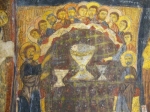 The frescoes of the Church of St. John |
|
 St. John's frescos. |
|
 St. John's frescos. |
|
 St. John's frescos. |
|
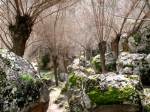 The Ihlara valley trail. |
|
 Women on the valley trail. |
|
 The River |
|
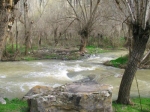 Another view of the river. |
|
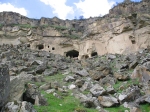 Cave dwellings carved into wall. |
|
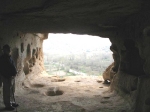 Fred inside one of the carved dwellings. |
|
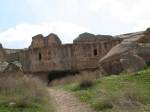 Acik Saray |
|
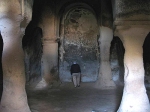 Monastery inside hall. |
|
 Ajik Saray |
|
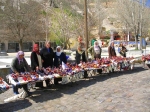 The doll sellers in the park.The Cappadoccia dolls are much sought after, the variety is vast, and prices here are low.
BELOW: Two views of Acik Saray |
|
We now come to the crossroads, Guzelyurt to our left, Ihlara straight ahead and Belisirma to our right. There’s a very nice gas station/rest stop here to the right as well and we stop for it. As we get back on the road and head for the village of Ihlara, Mount Hasan gets more beautiful by the kilometer. In minutes we’re driving down into Ihlara Village and around the south end of the valley rim. We come up on the west side of the valley and start north, in ten minutes we’re at the right turn for Belisirma. This is a gravel road recently topped and maybe even widened. In minutes we’re descending the central west valley wall. The road is fairly wide but I’m pleased to meet no one coming out. At the bottom now, we’re deposited at a tourist center. It’s three Lira to park and eight Lira to walk the park trail. We pay and leave the car; the trail parallels the Melendiz River, which cuts through the valley floor. We’re very much on our own, there are no other visitors. We start down the trail; there’s a mild breeze of cool fresh air in our face. The sounds of nature consume our every footstep. The first and most prominent sound is that of the river; the winter run-off has swollen it to near flood stage and it rages north just a few feet from the trail. Just slightly audible above the raging water are the calls of the birds; some shrill and others crow-like cries. Added to this off in the distance we hear a chain saw laboring under intense work.
The trail is fairly easy going and we enjoy the solitude. The views of the walls on both sides of us are magnificent, the rocks strewn around us are millenniums old and each one has come to rest here from far above. My literature suggests there are hundreds of churches and monasteries throughout this natural terrain. One note of significance, as if only one exists, is the mummy collection I’ve written about in the Nigde Museum. The priestess and the children were found in one of these cave dwellings.
We’re walking south along the west side of the river and we don’t get far before we hear voices, the chatter of women up ahead. Ah, there they are, two village women with bundles of sticks. Carol says, “good morning” and they beam with delight and respond with pleasant greetings. Carol goes on to talk about the work they are doing and they tell us they are collecting the wood for the fire to make bread. Their bundles are sitting on the trail as we meet them; they’re re-arranging the ropes that are holding the massive bundles together.
We bid them good day and we continue; we pause to look back and each woman has hoisted their bundle onto their back and bent from the burden head back toward the village. Just for the record; I could probably lift the bundle in question but to carry it far, NOT in my current condition. These ladies do this every day, I would expect, and probably start before most of us have breakfast! And, what a reminder that the old village ways are still just around the corner, only a few miles from our very modern city.
As we traverse the trail deeper into the valley it tends to rise and fall with the landscape. Here we must rise over a collection of rocks and then we duck under a rock across our path. We walk right beside the water and then 3 meters away and above the water. There are a couple of places we must cross some pretty muddy spots. Obviously springs are flooding from the hillside; the water is crystal clear as it runs across our path. There, look, I tell Carol, on the other side of the river there’s a man and a woman stacking logs. The woman is actually stacking the limbs in her pile and the guy is placing the tree trunks he has harvested in another large pile.
I stop to ask myself how in the world do they get those piles out of this valley. There is no road, even rudimentary, coming up through this valley on either side that I can see. I’m fully aware that manual labor is customary in these villages but the stack across the river seems far too immense. Well, I’m not going to solve that dilemma today so we simply push on. We don’t get too much further and the trail simply seems to dead end; I’m certain it doesn’t but I can see no way ahead that would be easy enough for the two of us and we must turn back.
Our little trek has been about an hour and most relaxing. (We’ve read that walking the length of the entire gorge takes three to four hours.) We get back into the car and return the way we came. Once we’re back at the intersection for Guzelyurt we turn north and head for Selime. This village is named for a former Sultan and boasts of a church/monastery complex. The eight Lira ticket from the valley floor gets into this ruin as well. We ascend a steep incline through the fairy chimneys and find ourselves in a carved hall overlooking the valley below; we discover later that we DID NOT ascend far enough to view the full monastery complex. It seems we totally missed the vast complex of tunnels and rooms (the cathedral) that one can visit here! But, we had enough difficulty getting to see what we did.
After this stop we head for the main highway between Aksaray and Nevsehir. Not far north on this road we note a historic sign for Asikli Hoyuk and decide to investigate. This detour takes us only a few minutes and we find the village of Kizilkaya. In this village is a Neolithic mound dated as far back as 12,000 years! Yes, that notation is correct; this mound is documented to be the earliest settlement in Central Anatolia. A multi-national team has been excavating here for several years and today unfortunately no one is available to allow us in, so we only peer over the fence. The sign highlighting the dig is too far from the fence so we can’t get a photo or any information from it. The team has also reconstructed a Neolithic house at the site using old materials and the old methods. If you would like to see more information about this site, they do have a website: http://www.asiklihoyuk.org with several pictures and articles in English as well as Turkish.
It’s a beautiful afternoon as we leave Kizilkaya and there’s open road as far as one can see (we’ve not been in this area before) so we drive leisurely and enjoy the scenery. Thirty minutes north of the village we begin to climb an ascending ribbon of asphalt; curving and climbing higher and higher above the plain cradling the Mamasun Dam. The road flattens now and in just minutes we’re turning east toward Nevsehir and Goreme.
Once back in Goreme we do something very different; we drive over to the base of the open air museum and walk through the tourist traps. I’m not certain why but Carol thought it would be something to do – HaHaHa. (Carol’s note: see last note about the pleasures of shopping in village markets!) Also, and more importantly, Carol wanted to see the interior of the cave church across the road from the museum. We walk up to it and then find we can’t get in without an open air museum ticket; they don’t sell tickets just to see this church! We walk back down the hill and get in the car, I drive back up the hill to park in the upper lot; they decide today no one gets into that lot! Why this happens we have no idea but I’m not parking below and walking the mountain to see anything, it’s not that important for me. We simply return to the village and have a late lunch at Cappadocia Kabob.
We decide after our lunch to drive up to Uchisar and see our friend Taner at Alaturca Carpets. The shop has been re-arranged; we sit down with refreshments and look at several kilims. We talk about the winter past and the tourist season coming up. Taner spent some time in Istanbul over the winter and we talk about the types of carpets selling and those not selling along with the severe escalation in prices. The carpet business is getting far more challenging as some pieces linger and other pieces sell out over night; we talk about how some regions simply aren’t making enough for demand and how the future looks for the business in general. We spend an hour with Taner and then head back to Goreme.
Back in Goreme now, we drop by Tribal Collection to tell Faruk to forget holding the Nain piece; we’ll simply leave our kismet (fate) on it. I hate to do that but it’s the Middle Eastern way. If it’s to be our piece, it’ll be there on our return. We head back to the Ottoman House and relax for a while.
It’s nearly 5:30 and I decide it’s time for dinner, once more we go down to Nazar Borek Gozleme and tonight the special is chicken soup; we order two with a Greek salad. Both are wonderful, I even opt for a second bowl of soup. A group of five comes in while we’re eating and a lady asks about the soup; I tell her it’s very good and I’m on my second helping. She orders the soup and after trying it gives me a thumbs-up sign; I must assume she found it good as well. Carol and I sit at the only table by the window and enjoy a leisurely dinner. We talk about what we did today and plan tomorrow as best we can; one never knows what detour may come in our day. We live our trips by the moment, just in case we get a better offer along the way. We plan to do this but if that comes up and offers more adventure, we simply change course and enjoy the day. We walk back to our hotel, in no particular rush, the evening is cool but it’s a wonderful walk.
Morning comes with both Carol and I awake, we freshen up and go for breakfast. As we enjoy the morning together, we semi-plan our day. After a nice meal we go back to the room; we collect our things and go to the car. We’re off to Soganli now; this is the little village directly south of Urgup where the famous Cappadocia Dolls are created. Carol wants to get a few more for her collection and the drive should be very pleasant. The winter has done nothing good to the roads but we make good time and see very little traffic. On the way our drive takes us through a rich and wondrous valley. The village of Sahinefendi is nestled at the bottom; we descend a steep winding road and ascend the other side in like manner, what a beautiful break in our morning trip through this incredible landscape.
Now near Soganli, we note as we turn off the main road to the village that many new homes and the requisite mosque have been constructed on this two-lane headed into the site. I’m thinking maybe a number of families have been evacuated from the old cave homes and resettled here. As we approach our objective, I expect to be stopped at the entry to pay admission; no one here, so I simply drive through and park at the public square. As we pull up, we see a few folks at the restaurant under the trees and a string of tourist stands with dolls. Usually there are two dozen or more women with tables full of dolls; today there might be eight of them. One lady, half bent over with age, brings her table over to join the others and in minutes a gentleman bring his table over too.
Carol studies the collection of vendors, all of them trying to draw her attention to their table, and tells them she will get to them one at a time. She begins her shopping with the gentleman and slowly inspects each table in turn. After making the entire round of tables she starts over and buys something from every individual. She tells me afterward that she’s always wanted to do that but there are usually far too many tables. For the record: the variety is vast and prices here are low. If you can get here, do so; it’s worth the drive, both in scenery and in doll purchasing. There are also about 10 churches in this valley, most in easy walking distance. The actual entry fee you pay here is for the walking tour through the cave churches in the village.
On our way out of the village a lady on the road is waving a bride doll and Carol wants to see it, so we stop. It’s very lovely and the lady wants very little for it so Carol buys it and we move on. As I again get to the entry, a gentleman stands in the road with his pad of tickets. I stop next to the guy; pay the six Lira he asks of me and we drive on. Once we’re out to the main road again, I turn east towards Yesilhisar. Once we’re in Yesilhisar, we turn north and it’s a quicker drive back to Urgup. Actually, if you want to go to Soganli on your way to Cappadocia, keep going northeast on the Nigde road toward Kayseri until you reach Yesilhisar then turn west to Soganli. It’s only 10 or 12 kilometers from that main intersection.
When we reach Urgup, we decide to have lunch and there’s a wonderful little restaurant called Corbaci. Literally translated, this name is soup man and we’ve talked about the place before; if you have the chance, do stop and have lunch here. We get two bowls of lentil soup and savor every spoon full. We’re certain this is a family owned and operated place; it’s immaculately kept and there’s plenty of room with two dining rooms and eight or ten tables in each. It’s located below the central square shops; you have to drive around the complex to get to the main shopping street if you enter from Goreme.
After a wonderful leisurely lunch, we head for Gülsehir to see a monastery and a cave church. We drive half as far northwest of Goreme as we did southeast getting to Soganli. We’ve never visited Gülsehir so look forward to new sites and additional learning. In Nevsehir we make a calculated turn and it takes us a half-hour out of our way; no problem, the weather is beautiful and we have scenery to match. The highway out this way is great and we make excellent time. Our drive takes us along the Kizilirmak River and now at Gülsehir we have to cross the river to get to the south of the city. We’re now on the road to Nevsehir; we should have been on this road coming north but as I said we didn’t make the proper decision 40 minutes ago.
There’s the sign to the church, we turn right and drive toward the hills just off to our left. A moment later we’re entering the parking lot at the Church of St. John site. There’s a little building for the site keeper and we go to the door, there’s no one here! We decide to look around and in a few minutes we see two little girls running into the lot. They rush up to the building and then circle it and one of the girls is calling for her father. They notice us but ignore us at the same time. I assume if they’re here the dad can’t be far away so we wait. It isn’t five minutes before a car comes down the road and pulls into the lot. The girls immediately confront him and we know this is our man.
The guy goes to the building entrance and we follow him, he wants to know if we’ve been here long and we tell him, “No, we pulled in just minutes ago.” He collects our entry fee and the keys he needs to open the church and off we go. From the outside we simply confront a very large conical portion of the hill. The gatekeeper pushes the door open and the girls rush in; we step inside after them. The auditorium is not as large as I anticipated and when my eyes adjust to the interior it looks pretty drab and ordinary. Then the guy points at the stairs and we look up; WOW is the only word that comes to mind. The frescos adorning the ceiling and upper walls in this church are stunning. There are several dozen different stories from the Bible illustrated here; the most striking for me is the Last Supper.
Carol is shooting one photo after another and moving first forward then back turning to get just the right angle on this one or that one until she has taking twenty photos! We admire the elegant and systematic portrayals for 30 minutes, maybe longer, before we reluctantly retreat. There’s no one about so we’re not rushed but we want to get to our next site. We thank the gentleman for his time and bid him and the girls a good day. As I write, I can’t help but imagine how sacred this place must have once been. Obviously, the congregation here would have been small but their pride would have been difficult to confine in this meager space.
Back on the road south toward Nevsehir now, we look for the monastery complex. There, Carol points out the site off to our right; I pull into the parking area and once more we look for a gatekeeper. There’s a larger building here but the doors are locked; the gate stands open so we simply start down the lane looking toward the rocks. There’s a chain saw up ahead and I wonder if our man is there clearing the lane. We crest a slight incline in the lane and see a car parked just ahead; there’s a creek just beyond the car and it appears to have flooded the roadway. This isn’t our man; we see a man and woman piling wood across the flowing water. These folks must be doing some clearing or collecting of wood.
On our right, up a grass covered hillside we see the carved rock face that draws us up the hill. Ah ha, this is the monastery complex and we’ve come up to what appears to be the main entrance. As usual, the interior is a burnt out shell of its former self. This is a large carved auditorium with four carved columns; it appears animals have been stabled here recently; I won’t go into the debris all over the place. This major hall is flanked on both sides by smaller rooms. It’s clear that this complex was very large in its time and it’s all carved from Cappadocia Tufa stone.
We walk around the side back toward the parking lot and above the lane where we entered. We now arrive at the living quarter’s complex; we enter a short hallway and emerge in a large room, off to one side is another room. We wander through a number of rooms on this level; some small others quite huge. This is without exaggeration a remarkable multiplex of working spaces and living quarters. I must repeat again; this landscape is riddled with these types of complexes and we never tire of exploring the ones we’ve not seen before. This collection of carved halls and living spaces is easy to access and fairly easy to move around in from room to room. Since we didn’t have to pay a fee, I’m not sure what it might cost but most of these sites are running 5 to 8 Lira; do visit this one if you get the opportunity.
Once more we’ve been on our own, no one has been at either site. We leave wondering why we’ve never seen either of these sites; they’re extremely easy to find and they’re not far from Goreme. Well, nothing to ponder further, we simply get into the car and drive south to Nevsehir. At Nevsehir we turn east toward Goreme; on the way we decide to pass right on by and go to Cavusin on the road to Avanos. We stopped here once some years ago and it was raining like mad so we didn’t get out of the car. We drive through the village to the mountain backdrop where the tourist usually go; today it’s lovely and as we pull into the area it’s obvious many people had the same idea. There are three large tour buses parked on the periphery of the parking area and several mini-buses coming and going.
There’s a parking area up a short lane and we drive up here to park. Just across the way from us is a tea garden, we walk over and take a table next to the building. As we sit and contemplate our next move; will we have tea or a soft drink, we opt to look around in the tourist shop. As we’re browsing, a gentleman speaks to us in English; he says he’s a tour guide and here with a troupe of students from Izmir. As he talks, the garden fills with teenagers; they’ve come down from the hills and are clamoring for ice cream and other refreshments. He wants to know where we learned our Turkish and we talk about living in Ankara and now in Adana. It turns out he himself is from Ankara and we talk about where we used to live there and the fact we really enjoyed the city so much.
He has to get on with his group and we cordially part company. Carol wants to have gozleme (a specialty flat bread filled with various items) and our new friend suggests we drive over to Zelve, where he insists the best is made. In just minutes we’re driving into the open air museum grounds at Zelve. Hey look! I point out to Carol there’s a turtle crossing the road; we decide to turn around and get a photo of it. There are signs all over this area cautioning us to look out for turtles but we’ve never seen one before. A car passes as I turn around and it stops; a young man gets out and goes to the turtle, he’s picking it up and taking it to the side of the road. CRUMB, I wanted a photo of it moving across the road, no matter, Carol get one of it at the side of the road; it’s completely withdrawn now and encased in its shell.
Again we turn around and complete the drive into the museum area. There are little kiosks all over that boast gozleme and ayran; we park the car and a gentleman comes running over to take a fee for parking – 2 Lira. We ask him which shop he would suggest for excellent gozleme and he indicates the cafeteria; we head toward it with several tourist shops trying to get our attention. Carol stops at one with some beautiful table cloths and says we’re going for gozleme and we’ll return in a while. We both get ayran and Carol orders her gozleme; she’s getting cheese and spinach. It takes a few minutes but it comes piping hot and Carol says, “Very tasty.”
We sit under a tree in the garden and enjoy the afternoon. After relaxing for a while we retreat to the table cloth shop and Carol does buy one; it’s a beautiful piece and goes very well in our dining room. We head for the car to return to Goreme; there’s a young couple in the parking lot looking for a ride in that direction so we offer our car. As I make room in the back seat, we learn the young people are from Germany on holiday. They thank us for the lift and we get on the road. They have hiked from Goreme this morning and were simply worn out by the day, so they needed a ride back. When we get to Goreme, they insist we have tea, coffee or other refreshment with them; we stop at Nazar Borek Gozleme and sit out over the canal across from the shop.
We sat with the couple for 30 minutes and talked about where they’ve been and where they’re looking yet to go. We talked about our travels and encourage them to see ALL they can in the time they have available to them. What a delightful encounter with two obviously enthusiastic travelers; we thank them for the refreshment and wish them a safe and joyous journey.
Carol has noticed a shop down the street that she would like to visit so after our tea with the young couple we’re off to Tabii Canim. This little shop has some truly unique gifts; slippers, hats, brooches, vests and scarves. The majority of the products offered are hand-pounded felt and fun; brilliant colors and charming designs. Stop by and say hello to Susan; during the summer the shop will be open longer hours and you’re welcome to browse. Before we leave, Carol buys a brooch for my mother; it’s a lovely fluted flower in soft pink.
As always happens, work trumps pleasure; our time is up and we must return home. One final observation related to the new autobahn; if possible, it’s even more extraordinary going south than it was going north!
Return to Website Home Page

| |

